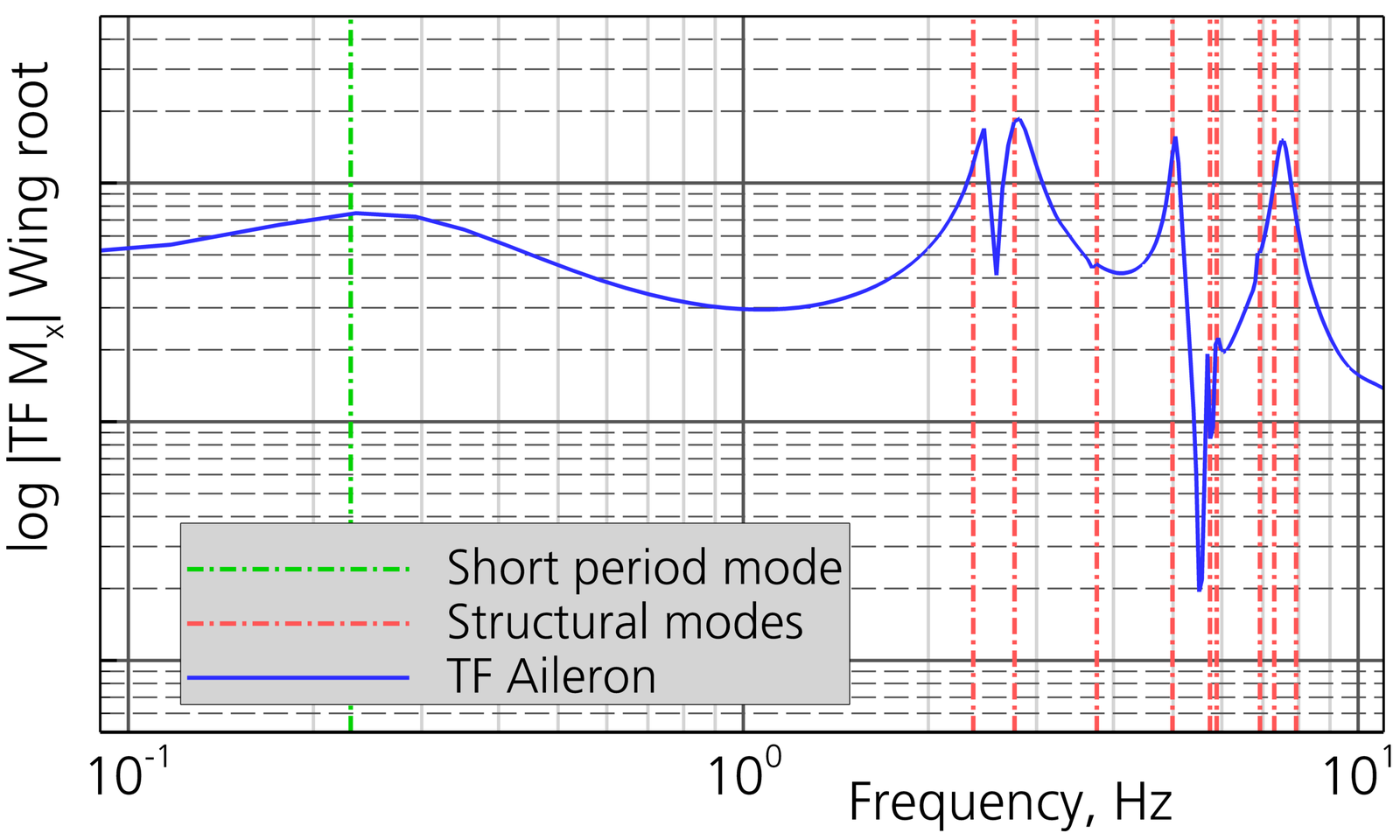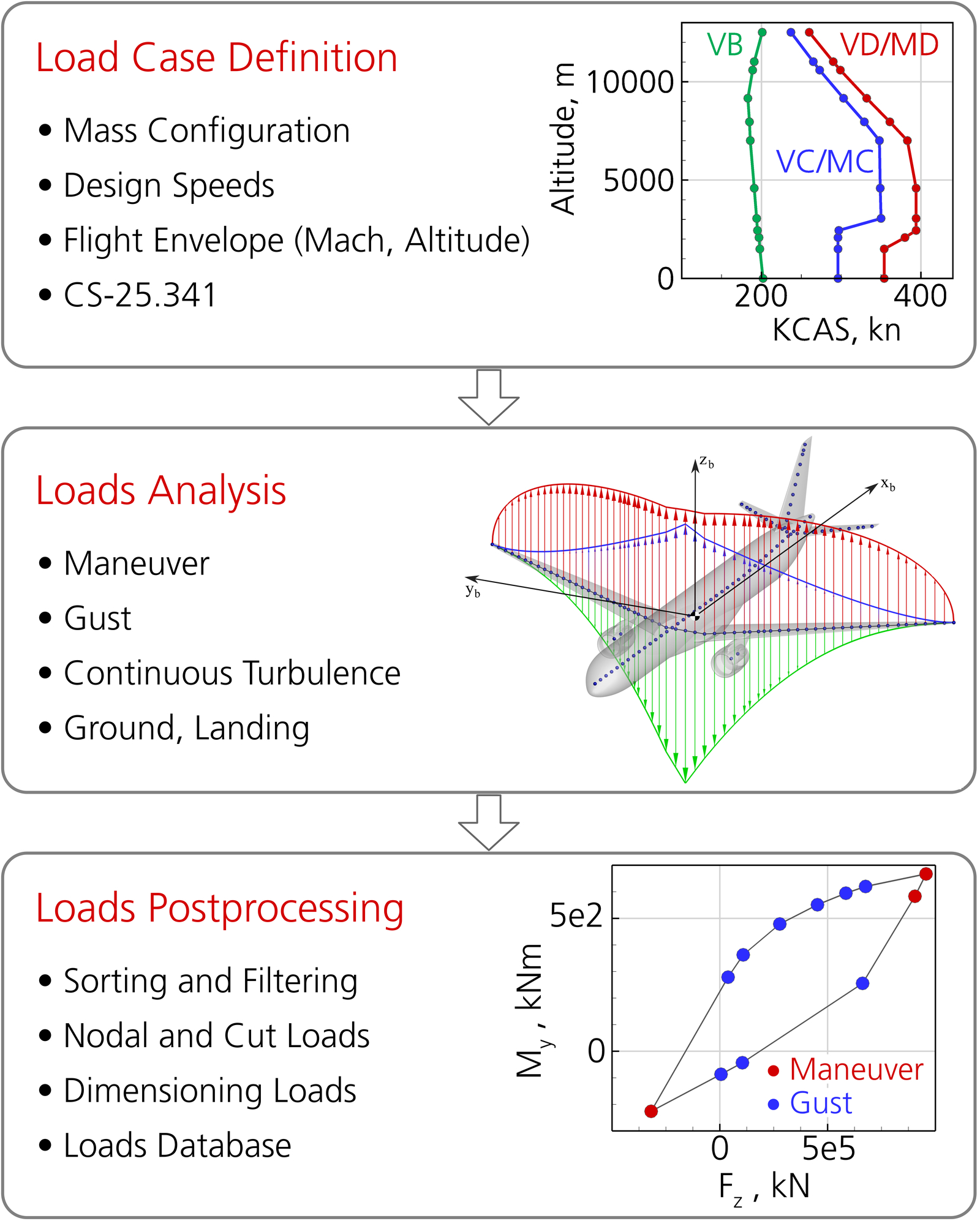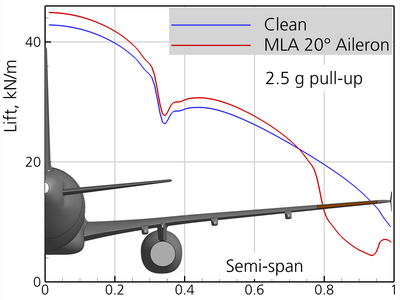Loads Analysis



The computation of flight and ground loads acting on the aircraft structure is one of the main tasks in the design and certification process of an aircraft. The term loads comprises all steady and unsteady, internal and external forces and moments that do mechanical work on the aircraft structure.
Loads have a multidisciplinary character, they result from the interaction of different disciplines. In addition to aerodynamics and structural dynamics, flight mechanics and flight control are particularly important. Loads arise during steady and unsteady flight conditions as well as during landing (landing impact) and during maneuvers of the aircraft on the ground. Across the entire life cycle of an aircraft, fatigue loads accumulate due to turbulent disturbances in the atmosphere, which must also be taken into account. Knowledge of the loads is essential for the dimensioning of the aircraft structure during the design process. Due to the interdependencies, loads analysis must be considered together with the structural design of an aircraft.
At the institute, mathematical and physical models and methods for flight dynamics simulations and loads analysis of aircraft are both applied and further developed.
The Loads Process
DLR is involved in a large number of design activities in national and international projects in collaboration with internal and external DLR partners. On the one hand, extensive loads calculations have to be carried out for both existing and new aircraft configurations for the purpose of structural dimensioning, flight performance evaluation and validation purposes. On the other hand, DLR operates research aircraft of various categories; missions with these carriers sometimes require major modifications to the aircraft, which often have to be covered by new certifications. The DLR loads process can be divided into three stages: load case definition, loads analysis and loads post-processing. Current and future developments at the institute are aimed at extensive expansions of the loads process. The goal is the comprehensive computation of loads in all areas of the flight envelope for new and complex aircraft configurations including aerodynamic and structural non-linearities with specified accuracy and computing time.

Methods for Flight Dynamics and Loads Analyses
Linear and non-linear methods are used for the computation of maneuver and gust loads. Most analyses use linear structural models and aerodynamic methods based on potential theory, such as the vortex lattice method (VLM) for steady and quasi-steady aerodynamics, and the double lattice method (DLM) for unsteady aerodynamics. The availability of HPC clusters enables the use of highly accurate CFD based methods for steady and unsteady (both time and frequency domain) maneuver and gust loads computations which consider non-linear aerodynamic effects such as flow separation or shock boundary layer interaction, which typically occur in the transonic flight regime. On the structural side, detailed as well as reduced finite element models are used in physical and modal formulations. Multibody simulation methods are used to calculate landing loads. Furthermore, (geometrically) non-linear methods for structural dynamics are developed and used to simulate aircraft configurations and wind tunnel models with large deformations.
Maneuver and Gust Load Alleviation

Active and passive technologies are used for the alleviation of static and dynamic flight loads. They effectively reduce the dimensioning loads for structural optimization and thus enable the further reduction of the primary wing mass. Static (MLA) and dynamic (GLA) load alleviation is based on control laws that deflect selected control surfaces to redistribute the aerodynamic loading of the wing. The simulation methods of the institute are used to derive highly accurate models of the aeroelastic system to assess its characteristics or for the synthesis of controllers.
Loads Analyses for highly flexible Aircraft with Large Deformations
Structural nonlinearities play a decisive role not only in loads analysis, but also in future aircraft design, mainly for configurations with high aspect ratio wings. Large deformations can occur as a result of structural optimization, for example due to large strain allowables in fiber composites, or they can be introduced into the aircraft design intentionally, e.g. for passive load reduction. The accurate consideration of geometric non-linearities in loads analyses requires suitable aerodynamic and structural dynamics methods. Aerodynamic loads can be calculated geometrically accurate by VLM and CFD methods, even with large deformations. On the structural side, both commercial simulation tools (mostly in Lagrangian formulation) and nonlinear modal methods (extended modal approach) are used at the institute for the flight dynamics simulation of free-flying aircraft with large deformations.

